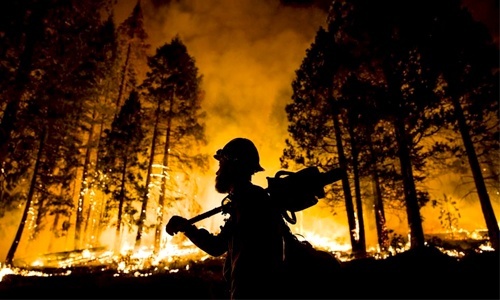
Historic Wildfire Season Has Burned More Than 7.5 Million Acres (That’s Larger Than Massachusetts)

Just how bad are the wildfires in the western U.S.? Answer: pretty damn bad. This wildfire season was predicted to be worst one yet and it looks like experts are correct. More than 7.5 million acres have burned in wildfires this year—an area roughly the size of Massachusetts—according to the National Interagency Fire Center. This is the first time in 20 years that the area charred has exceeded 7 million acres by this date, according to the National Interagency Fire Center.
7 milliion acres and counting: The West’s Wildfire Season Is Getting Even Worse http://t.co/DDyobmp3dm #climate pic.twitter.com/Jt5BQNVncZ
— CitizensClimateLobby (@citizensclimate) August 23, 2015
The massive fire burning in north central Washington, dubbed the Okanogan Complex, has surpassed last year’s record-setting Carlton Complex to become the largest fire in the state’s history. The blaze is estimated to be 400 square miles as of Monday. Fire spokesman Rick Isaacson told NBC News he fears the fire may burn until the end of October when the rain and snow season arrives.
“It’s only Aug. 24th,” he said. “In our district we could see this go clear to the first of November.” The fire was only 17 percent contained as of Tuesday with hot, dry and windy conditions stymying the efforts of the nearly 1,300 people battling the flames.
Western Wildfires: On the Front Lines With Firefighters Battling the Blazes. @Miguelnbc reports: http://t.co/IpxBLbBVgt
— NBC Nightly News (@NBCNightlyNews) August 25, 2015
And Washington is not alone. Idaho currently holds the dubious title for the highest number of active, large wildfires. Eleven states are currently reporting at least one large fire: Arizona (1), California (11), Colorado (1), Idaho (21), Louisiana (1), Montana (10), New Mexico (1), Oregon (9), Texas (3), Utah (1) and Washington (12). That makes for a total of 71 active large fires burning nearly 1.6 million acres. And only two of them (both in Texas) are 100 percent contained.
Here’s a map from AirNow showing the air quality from all the fires:

And then there’s Alaska, which is in a league of its own. Climate Central reports that Alaska is entering a “new era for wildfires” due to the rapid warming of the Arctic. The state has seen nearly 5 million acres burn—an area the size of Connecticut. At one point earlier this summer, the state had more than 300 active blazes. Currently, the Last Frontier is dealing with 166 active wildfires.

 233k
233k  41k
41k  Subscribe
Subscribe 